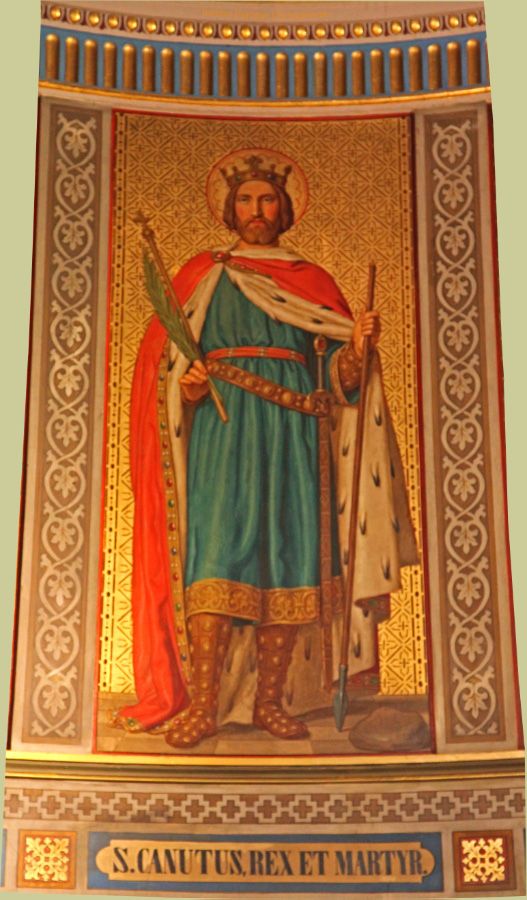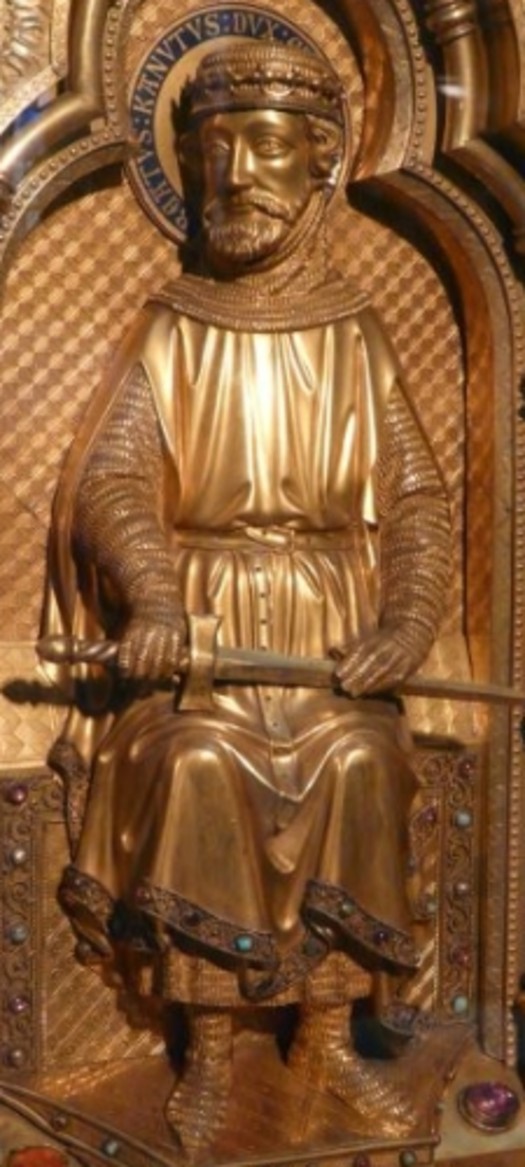Saint of the Day – 10 July– St Canute IV of King of Denmark (c 1042-1086) Martyr – known as “Canute the Holy” – also known as Canute, Canute IV, Canutus, Cnut, Knud IV, Knut, Knute. He was King of Denmark from 1080 until 1086. Born c 1042, one of the many sons of Sweyn II Estridsson and he died by the sword in 1086 in the Church of Saint Alban on the island of Fünen, Denmark. Canute was an ambitious king who sought to strengthen the Danish monarchy, devotedly supported the Roman Catholic Church and had designs on the English throne. Slain by rebels in 1086, he was the first Dane to be Canonised. He was recognised as Patron of Denmark in 1101.
He was born in c 1042 and ascended to the throne in 1080. He was ambitious and devout—he appropriated land for the Church and arranged for the support of clergy by tithes. He was generous in building churches and schools.
Canute was a strong, wise king of Denmark. He was a great athlete, an expert horseman and a marvellous general. At the beginning of his reign, he led a war against the barbarians who were threatening to take over the civilised world. King Canute and his army defeated them. He loved the Catholic faith so much that he introduced it to people who had never heard of Christianity.
St Canute knelt in Church at the foot of the altar and offered his crown to the King of kings, Jesus. King Canute was very charitable and gentle with his people. He tried to help them with their problems. Most of all, he wanted to help them be true followers of Christ.
However, a rebellion broke out in his kingdom because of the laws he had made about supporting the Church. On 10 July 1086, Canute and his men took refuge inside the wooden St Alban’s Priory in Odense. While his enemies were still outside, King Canute received the Sacraments of Reconciliation and Holy Communion. He felt compassion for those who were upset enough to kill him. With all his heart he forgave his enemies. The rebels stormed into the Church and slew Canute, along with his brother Benedict and seventeen of their followers, before the altar. According to chronicler Ælnoth of Canterbury, Canute died following a lance thrust in the side.

He was succeeded by Olaf as Olaf I of Denmark.
The story of King Canute and the tide illustrates the piety or humility of King Canute the Great, recorded in the 12th century by Henry of Huntingdon.
In the story, Canute demonstrates to his flattering courtiers that he has no control over the elements (the incoming tide), explaining that secular power is vain compared to the supreme power of God. The episode is frequently alluded to in contexts where the futility of “trying to stop the tide” of an inexorable event is pointed out but usually misrepresenting Canute as believing he had supernatural powers, when Huntingdon’s story in fact relates the opposite.
In Huntingdon’s account, Canute set his throne by the sea shore and commanded the incoming tide to halt and not wet his feet and robes. Yet “continuing to rise as usual [the tide] dashed over his feet and legs without respect to his royal person. Then the king leapt backwards, saying: ‘Let all men know how empty and worthless is the power of kings, for there is none worthy of the name but He whom heaven, earth and sea obey by eternal laws.'” He then hung his gold crown on a Crucifix and never wore it again “to the honour of God the almighty King.”
Because of his Martyrdom and advocacy of the Church, Canute quickly began to be considered a saint. Under the reign of Olaf, Denmark suffered from crop failure, which was seen as divine retribution for the sacrilege killing of Canute. Miracles were soon reported as taking place at his grave and his Canonisation was already being sought during the reign of Olaf. On 19 April 1101, persuaded by the envoys from Eric III of Denmark, Pope Paschal II confirmed the “cult of Canute” that had arisen and King Canute IV was Canonised as a Saint under the name San Canuto. He was the first Dane to be Canonised.
In 1300, his remains and those of his brother Benedict were interred in Saint Canute’s Cathedral, built in his honour, where his bones are on display.


3 thoughts on “Saint of the Day – 10 July– St Canute IV of King of Denmark (c 1042-1086) Martyr”